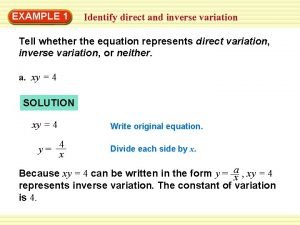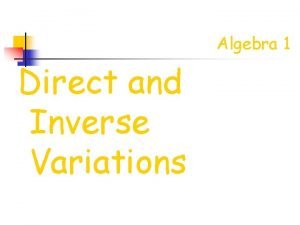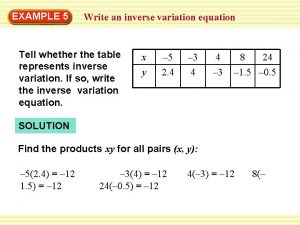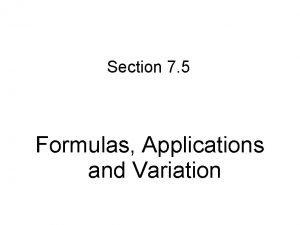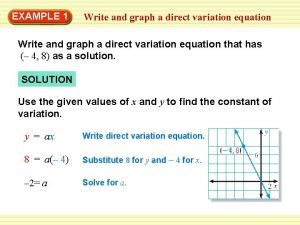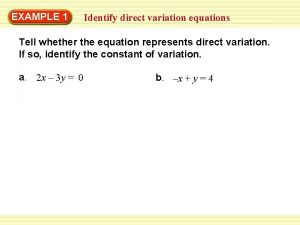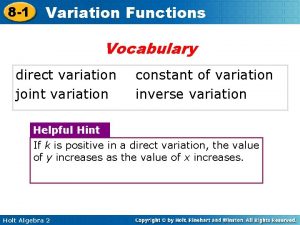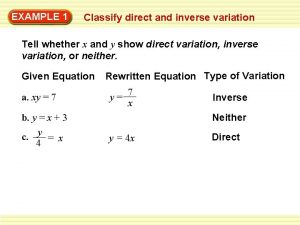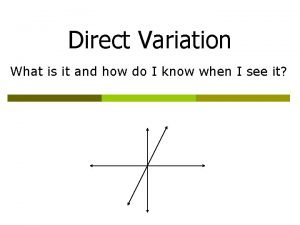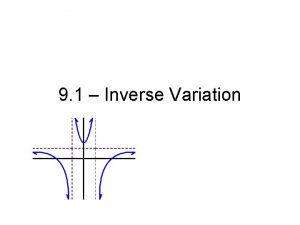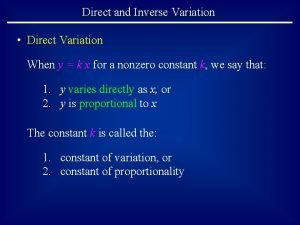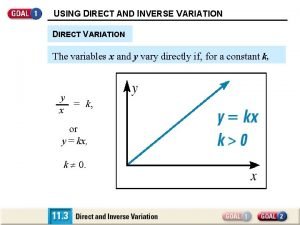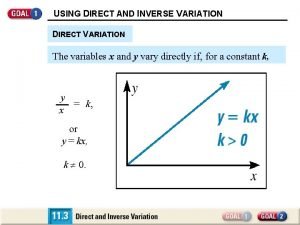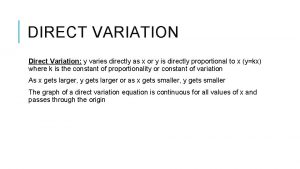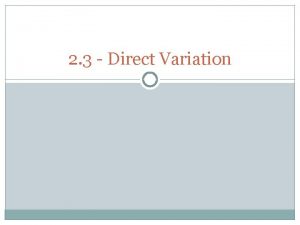Direct Variation What is it and how do























- Slides: 23

Direct Variation What is it and how do I know when I see it?

What is a Direct Variation or a Direct Proportion? p Used to compare two values and to see how one value affects the other value p When 1 quantity always changes by the same factor (the constant) as another, the 2 quantities are in direct proportion. The 2 quantities always have equivalent ratios

How do we find know if we have a direct variation? p You can look at: 1. EQUATIONS 2. TABLES 3. GRAPHS to see how two values affect one another

Direct Variation Equations: • Y varies directly as x means that y = kx where k is the constant of variation. • Another way of writing this is k = • X is the independent variable • Y is the dependent variable • K is the constant of proportionality

Examples of Direct Variation Equations (y = kx)… py py py = = = 4 x x 2 x 2. 5 x ⅝x 0. 75 x k k k = = = 4 1 2 2. 5 ⅝ 0. 75

Direct Variation & Tables of Values You can make a table of values for “x” and “y” and see how the values behave. You could have a direct variation if… p As “x” increases in value, “y” also increases in value OR p As “x” decreases in value, “y” also decreases in value

Examples of Direct Variation: Note: As “x” increases, 6, 7, 8 “y” also increases. 12, 14, 16 What is the constant of variation of the table above? Start with the direct variation equation: y = kx Pick one pair of x and y values and substitute into the equation 12 = k · 6 (this is a one-step equation, so solve for k) 12/6 = k → k=2 Now you can write the equation for this direct variation: y = 2 x

Examples of Direct Variation: Note: X decreases, 30, 15, 9 And Y decreases. 10, 5, 3 What is the constant of variation of the table above? Start with the direct variation equation: y = kx Pick one pair of x and y values and substitute into the equation 10 = k · 30 (this is a one-step equation, so solve for k) 10/30 = k → (simplify 10/30) → k = ⅓ Now you can write the equation for this direct variation: y = ⅓ · x

Is this a direct variation? If yes, give the constant of variation (k) and the equation. Yes! y = kx • Pick an x & y pair and substitute into the direct variation equation to solve for k. • Remember the constant must hold true for every x, y pair 6=k· 4 k = 6/4 = 3/2 = 1 ½ Therefore the equation for this table is: y = 1 ½ · x

Is this a direct variation? If yes, give the constant of variation (k) and the equation. Yes! y = kx * Pick an x & y pair and substitute into the direct variation equation & find k. 25 = k · 10 25/10 = k 5/2 or 2 ½ = k * Remember the constant must hold true for every x, y pair. Therefore the equation for this table is: y=2½·x

Is this a direct variation? If yes, give the constant of variation (k) and the equation. No! If you look at the values in the table, you should notice as “x” decreases, “y” increases, so you know you CANNOT have a direct variation! Also, there is no constant of proportionality. There is not one number you multiply by x to get y for each pair in the table.

Which is the equation that describes the following table of values? 1. 2. 3. 4. y = -2 x y = 2 x y= ½x xy = 200 Answer Now

Using Direct Variation to find unknowns (y = kx) Given y varies directly with x, and y = 28 when x=7, Find x when y = 52. HOW? ? ? 2 step process 1. Find the constant of variation y = kx → 28 = k · 7 (divide both sides by 7) k=4 2. Use y = kx. Find the unknown (x). 52= 4 x or 52/4 = x x= 13 Therefore: X =13 when Y=52

Using Direct Variation to find unknowns (y = kx) Given that y varies directly with x, and y = 3 when x=9, Find y when x = 40. 5. HOW? ? ? 2 step process 1. Find the constant of variation. Y = kx → 3=k· 9 (divide both sides by 9) K = 3/9 = 1/3 2. Use y = kx. Find the unknown (x). y= (1/3)40. 5 y= 13. 5 Therefore: X =40. 5 when Y=13. 5

Real World Examples of Direct Variation Situations… The more time I drive at a constant rate, the more miles I go. p If I increase a recipe for more people, the more of an ingredient I need. p The more hours I work, the more money I make. p The more CD’s I purchase, the more money it costs. p The less cheese I buy at the deli, the less money I pay. p

Using Direct Variation to solve word problems Problem: Step One: Find points in table A car uses 8 gallons of gasoline to travel 290 miles. How much gasoline will the car use to travel 400 miles? Step Two: Find the constant of variation and equation: y = kx → 290 = k · 8 290/8 = k y = 36. 25 x Step Three: Use the equation to find the unknown. 400 =36. 25 x 36. 25 or x = 11. 03

Using Direct Variation to solve word problems Problem: Step One: Find points in table. Julio wages vary directly as the number of hours that he works. If his wages for 5 hours are $29. 75, how much will they be for 30 hours Step Two: Find the constant of variation. y = kx → 29. 75 = k · 5 k = 5. 95 Step Three: Use the equation to find the unknown. y = kx y = 5. 95 · 30 y = 178. 50

Direct Variation and Its Graph

Characteristics of Direct Proportion Graph… p The graph will always go through the ORIGIN (point 0, 0) on the coordinate plane) & will be in Quadrants I and III only (for this year we’re only required to graph in Quadrant I – all positive numbers) p The graph will always be a straight line p As the “x” values increase, the “y” value will also increase

Independent VS. Dependent p The x-axis is the independent variable; this means it does NOT depend on the y value p The y-axis is the dependent variable; this means it DOES depend on the x variable for its value.

Example… p You went on a hiking trip, and you graphed your distances at various times throughout your trip. As the time you hiked increased, the distance traveled also increased. The distance depends on the time; therefore, the distance is the dependent variable and it is graphed on the y-axis (vertical). The time is independent (time still goes on whether or not the distance changes), so it is graphed on the x-axis (horizontal).

Tell if the following graph is a Direct Variation or not. No No

Tell if the following graph is a Direct Variation or not. No Yes No
 What is a direct variation
What is a direct variation Direct variation vs inverse variation
Direct variation vs inverse variation Prediction interval formula
Prediction interval formula Inverse variation
Inverse variation Direct inverse graph
Direct inverse graph What is the difference between direct and inverse variation
What is the difference between direct and inverse variation Direct vs inverse variation
Direct vs inverse variation Direct proportion formula
Direct proportion formula Which of the following functions is a direct variation
Which of the following functions is a direct variation The drag force f on a boat varies jointly
The drag force f on a boat varies jointly Direction variation equation
Direction variation equation Which graph represents a direct variation?
Which graph represents a direct variation? Graph of direct variation
Graph of direct variation Direct variation equation examples
Direct variation equation examples Direkte proportionalität
Direkte proportionalität Example of direct variation
Example of direct variation Direct variation formula
Direct variation formula Constant of proportionality.
Constant of proportionality. Variation functions
Variation functions Direct variation relationship
Direct variation relationship Direct variation poster
Direct variation poster Classify the following as direct inverse or neither
Classify the following as direct inverse or neither Direct variation define
Direct variation define Direct variation problems
Direct variation problems



